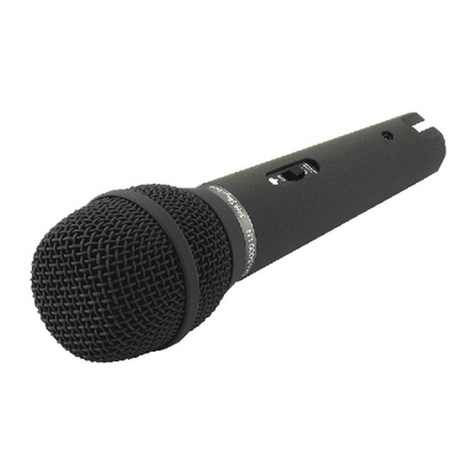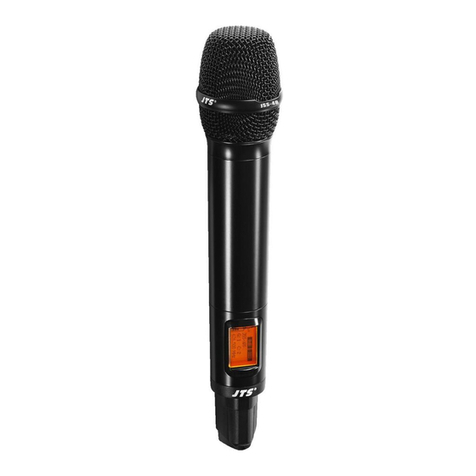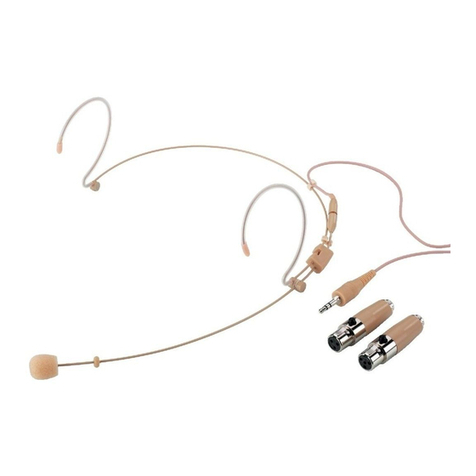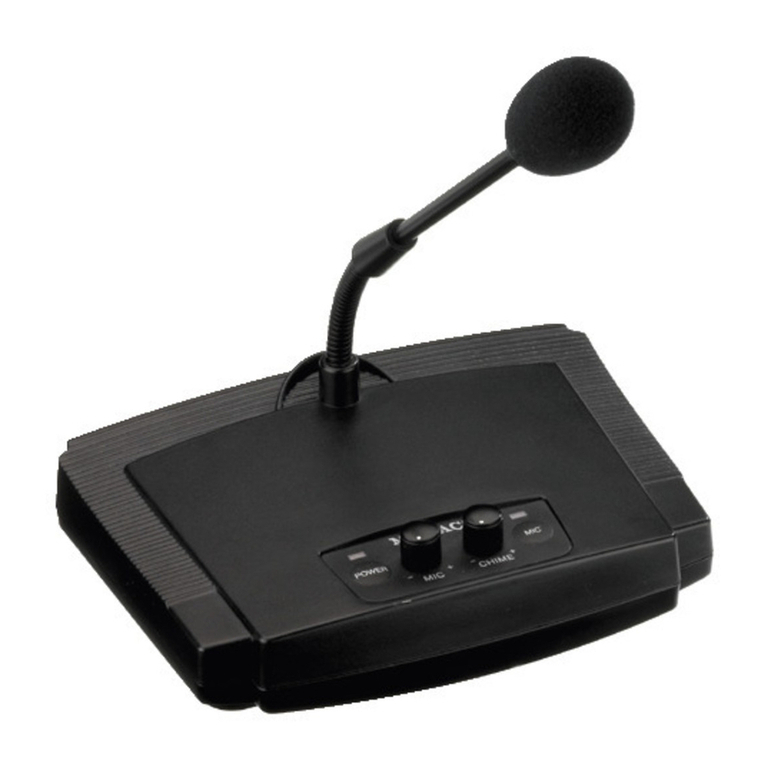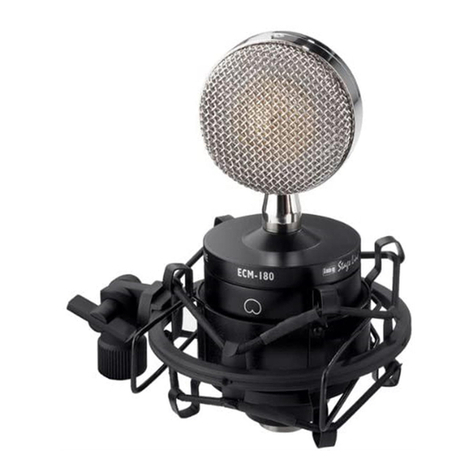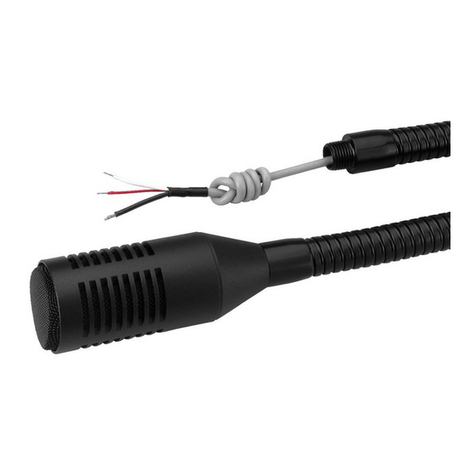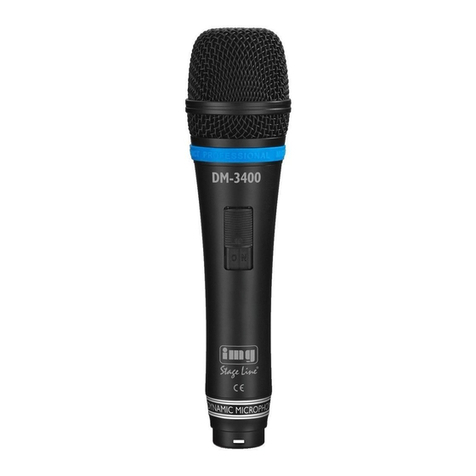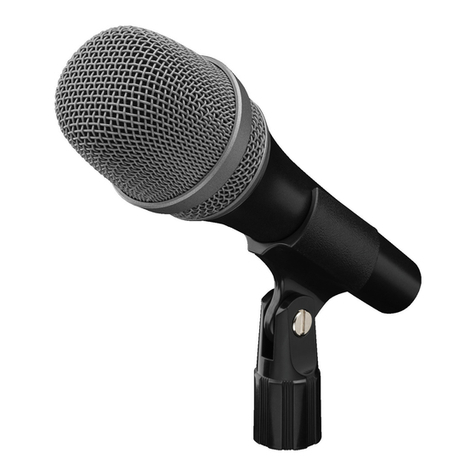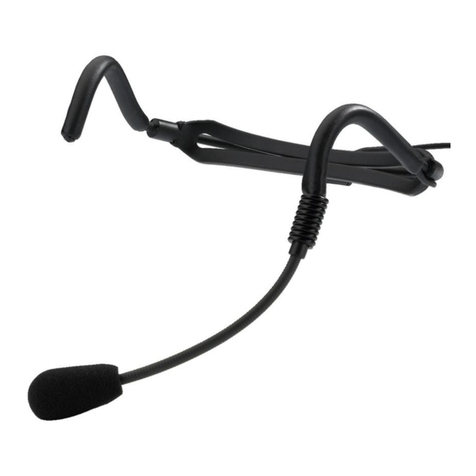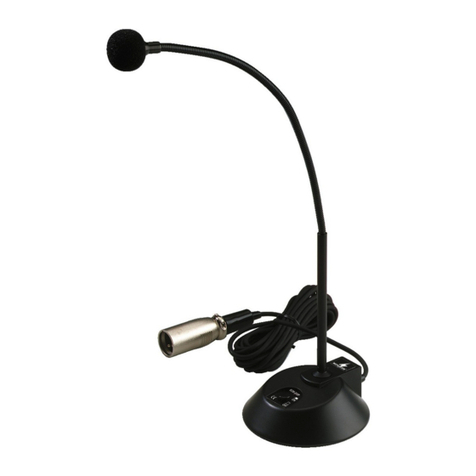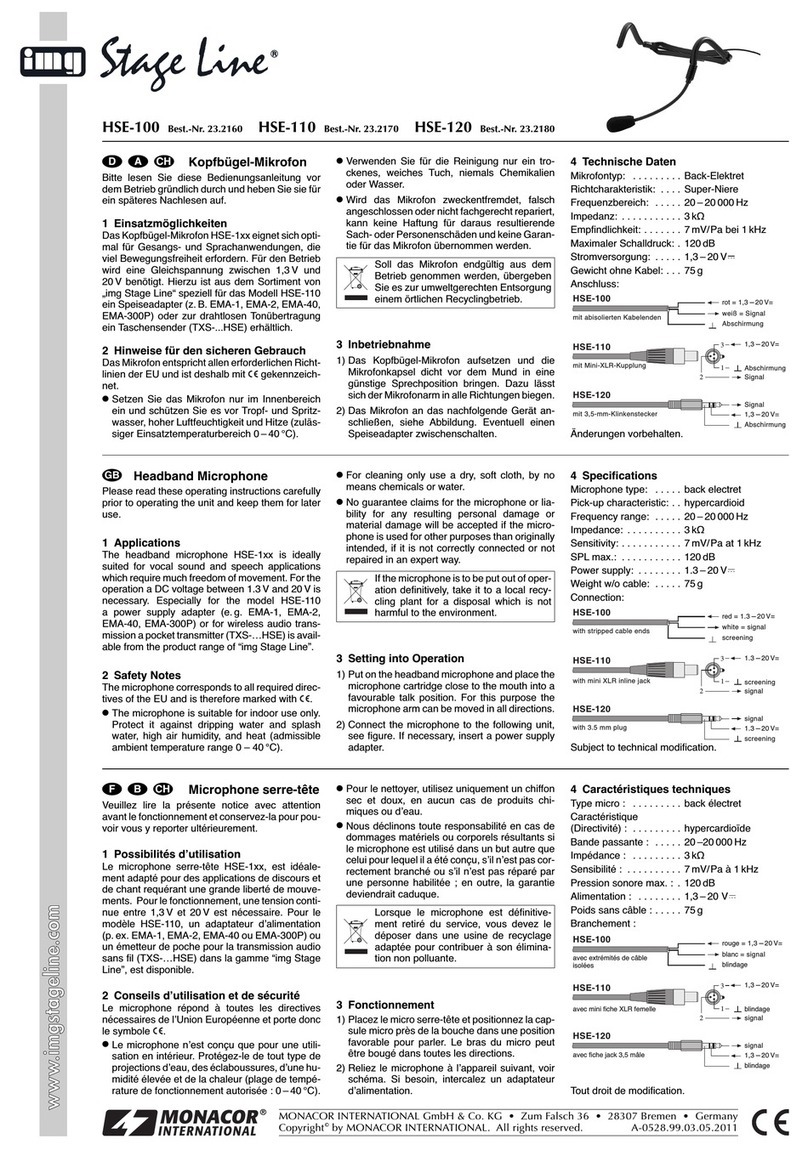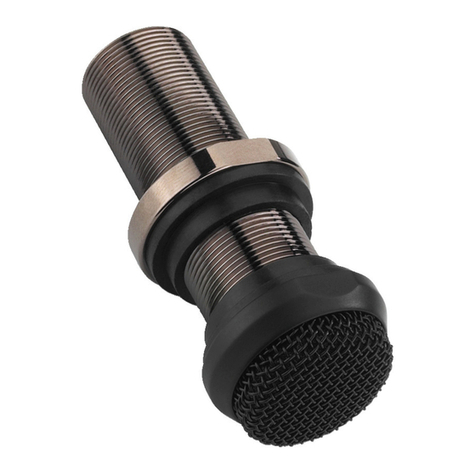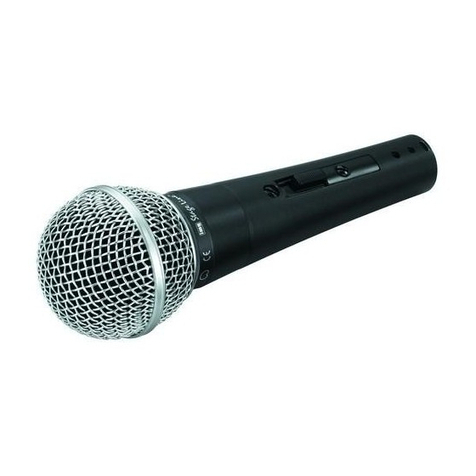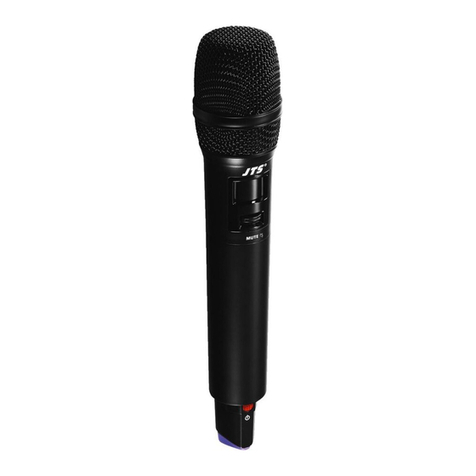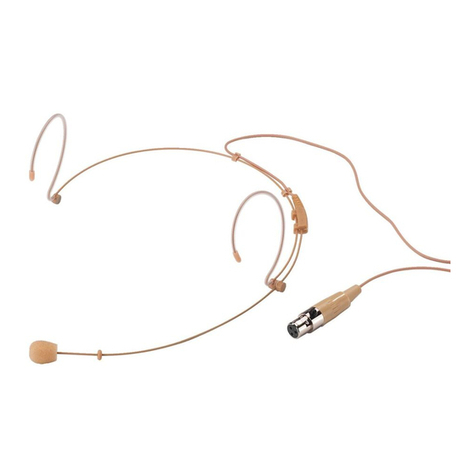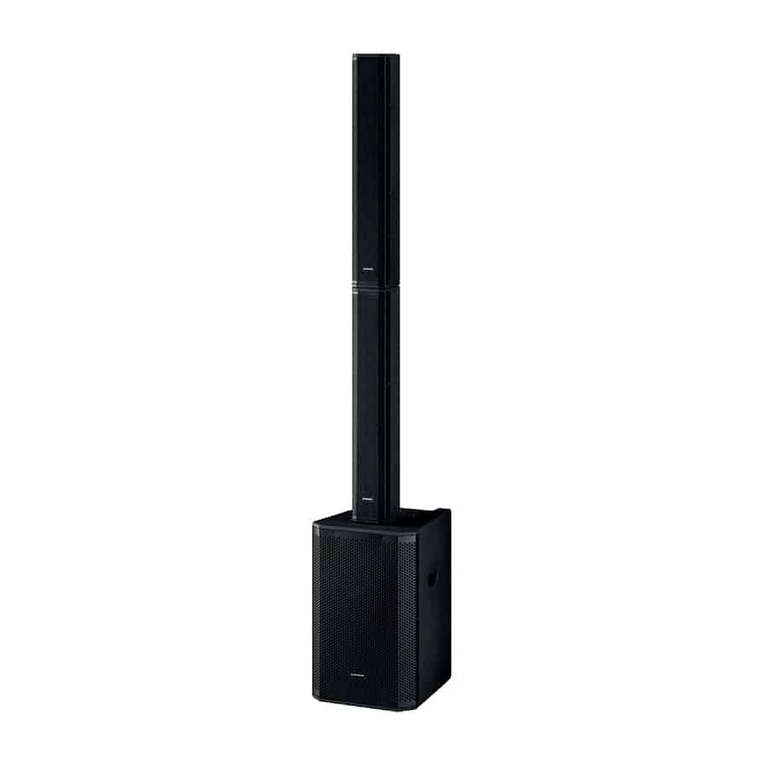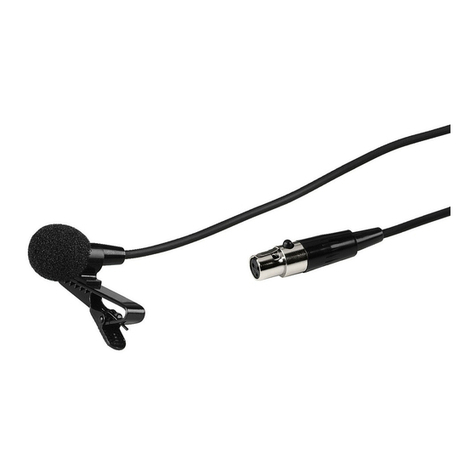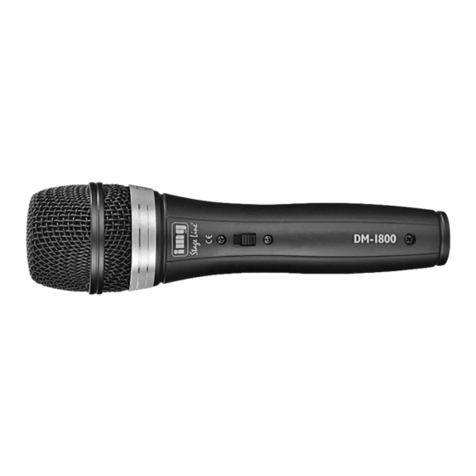Elektret-Mikrofon
Einsatzmöglichkeiten
Dieses leichte Elektret-Handmikrofon ist besonders
gutfürSprachanwendungen,wiez.B.Interviews,Vor-
träge, geeignet und lässt sich optimal für Aufnahme-
zwecke (z.B. mit MD-Recorder) einsetzen.
Hinweise für den sicheren Gebrauch
Das Mikrofon entspricht der EMV-Richtlinie für elek-
tromagnetische Verträglichkeit 89/336/EWG.
●SchützenSiedasMikrofonvorFeuchtigkeitundHit-
ze (zulässiger Einsatztemperaturbereich 0–40 °C).
Das Mikrofon ist nicht wetterfest. Achten Sie des-
halb bei Außenaufnahmen auf Schutz vor Regen
und sonstigem Niederschlag.
●Verwenden Sie für die Reinigung nur ein trockenes,
weiches Tuch, niemals Chemikalien oder Wasser.
●Wird das Mikrofon zweckentfremdet, falsch ange-
schlossen oder nicht fachgerecht repariert, kann
keine Haftung für daraus resultierende Sach- oder
Electret Microphone
Applications
This lightweight hand-held electret microphone is
ideally suited for speech applications (e.g. interviews,
lectures) and recordings (e.g. by MD recorder).
Safety Notes
The microphone corresponds to the directive for elec-
tromagnetic compatibility 89/336/EEC.
●Protect the microphone against humidity and heat
(admissible ambient temperature range 0–40°C).
The microphone is not weatherproof; protect it
against rain or other precipitation when making out-
door recordings.
●For cleaning only use a dry, soft cloth, by no means
chemicals or water.
●No guarantee claims for the microphone or liability
for any resulting personal damage or material dam-
age will be accepted if the microphone is used for
other purposes than originally intended, if it is not
correctly connected, or not repaired in an expert
way.
●If the microphone is to be put out of operation defi-
nitively, take it to a local recycling plant for a dis-
posal which is not harmful to the environment.
●Exhausted batteries do not belong in the household
rubbish; always take them to a special waste dis-
posal (e.g. collecting container at your retailer).
Setting the Microphone into Operation
1) Slightly press the grooves on the battery compart-
ment cover on the rear side of the microphone
while simultaneously sliding the cover downwards
in arrow direction so that it can be removed. Insert
a 1.5V battery of size AA according to the imprint
in the battery compartment, then close the com-
partment.
If the microphone is not used for a longer period
(e.g. for more than a week), the battery should be
removedtopreventdamagedueto battery leakage.
2) Place the windshield, if required.
3) Connect the microphone cable to the following
unit (e.g. camcorder, MD recorder). If the unit is
equipped with a 6.3mm jack, use the supplied
adapter plug.
4) To switch on the microphone, set the switch to the
upper position “ON” (red marking will appear in the
small window above the switch).
Specifications
Pick-up characteristic: . . cardioid
Frequency range: . . . . . 50–16000Hz
Sensitivity: . . . . . . . . . . . 5.6mV/Pa at 1 kHz
Impedance: . . . . . . . . . . 1kΩ
Max. SPL: . . . . . . . . . . . 110dB
S/N ratio: . . . . . . . . . . . 50dB
Power supply: . . . . . . . . 1.5V battery of size AA
Dimensions: . . . . . . . . . Ø 29mm x 195mm
Weight (with cable): . . . 170g
Connection cable: . . . . . 6m cable with 3.5mm
mono plug
According to the manufacturer. Subject to technical change.
Copyright©by MONACOR INTERNATIONAL GmbH & Co. KG, Bremen, Germany. All rights reserved. A-0181.99.01.12.2003
®
Personenschäden und keine Garantie für das Mi-
krofon übernommen werden.
●SolldasMikrofon endgültig aus dem Betrieb genom-
men werden, übergeben Sie es zur umweltgerech-
ten Entsorgung einem örtlichen Recyclingbetrieb.
●WerfenSieverbrauchteBatteriennicht in denHaus-
müll, sondern geben Sie sie nur in den Sondermüll
(z.B. Sammelbehälter bei Ihrem Einzelhändler).
Inbetriebnahme
1) Auf der Mikrofonrückseite die Riffelung am Batte-
riefachdeckel leicht eindrücken und den Deckel
gleichzeitig in Pfeilrichtung nach unten schieben,
so dass er sich abnehmen lässt. Eine 1,5-V-Mig-
nonbatterie (Größe AA) gemäß dem Aufdruck im
Batteriefach einsetzen und das Fach schließen.
Wird das Mikrofon länger nicht benutzt (z.B.
länger als eine Woche), sollte die Batterie heraus-
genommen werden, um Schäden durch ein even-
tuelles Auslaufen der Batterie zu vermeiden.
2) Bei Bedarf den Windschutz aufstecken.
3) Das Mikrofonkabel an das nachfolgende Gerät
(z.B. Camcorder, MD-Recorder) anschließen. Bei
einer 6,3-mm-Klinkenbuchse am Gerät den beilie-
genden Adapterstecker verwenden.
4) Zum Einschalten des Mikrofons den Schalter in die
obere Position „ON“ (rote Markierung erscheint im
Sichtfenster über dem Schalter) stellen.
Technische Daten
Richtcharakteristik: . . . . Niere
Frequenzbereich: . . . . . 50–16000Hz
Empfindlichkeit: . . . . . . . 5,6mV/Pa bei 1kHz
Impedanz: . . . . . . . . . . . 1kΩ
Max. Schalldruck: . . . . . 110dB
Signal/Rausch-Abstand: 50dB
Stromversorgung: . . . . . 1,5V-Mignonbatterie (AA)
Abmessungen: . . . . . . . Ø 29mm x 195mm
Gewicht (inkl. Kabel): . . 170g
Anschlusskabel: . . . . . . 6-m-Kabel mit 3,5-mm-
Mono-Stecker
Laut Angaben des Herstellers. Änderungen vorbehalten.
GB
ECM-50
Best.-Nr. 23.3450
wwwwww..iimmggssttaaggeelliinnee..ccoomm
D A CH
Microphone électret
Possibilités d’utilisation
Ce microphone main électret léger est très bien adap-
té pour des utilisations en discours comme par exem-
ple des interviews, conférences et peut être utilisé de
manière optimale pour des enregistrements (par
exemple avec un enregistreur de mini-disques).
Conseils d’utilisation et de sécurité
Lemicrophonerépondà lanormeeuropéenne 89/336/
CEE, relative à la compatibilité électromagnétique.
●Protégez le microphone de l’humidité et de la cha-
leur (plage de température de fonctionnement au-
torisée 0–40 °C). Le microphone n’est pas protégé
contre les intempéries. Pour des enregistrements
en extérieur, veillez à le protéger de la pluie et au-
tres précipitations.
●Pourle nettoyer,utilisezuniquementunchiffon secet
doux, en aucun cas de produits chimiques ou d’eau.
●Nousdéclinonstouteresponsabilitéen cas de dom-
mages matériels ou corporels résultants si le micro-
phone est utilisé dans un but autre que celui pour
lequel il a été conçu, s’il n’est pas correctement
branché ou s’il n’est pas réparé par une personne
habilitée;en outre, la garantie deviendrait caduque.
●Lorsque le microphone est définitivement retiré du
circuit de distribution, vous devez le déposer dans
une usine de recyclage adaptée pour contribuer à
son élimination non polluante.
●Ne jetez pas les batteries usagées dans la poubelle
domestique mais dans une poubelle adéquate (ra-
menez-les par exemple à votre détaillant).
Fonctionnement
1) Sur la face arrière du micro, enfoncez légèrement la
partie striée sur le couvercle du compartiment batte-
rie et poussez simultanément le couvercle dans le
sens de la flèche vers le bas pour le retirer. Insérez
une batterie 1,5V de type R6 selon les indications
figurantdanslecompartimentbatteriepuisrefermez.
En cas de non-utilisation prolongée (supérieure
àunesemaineparexemple),retirezlabatteriepour
éviter qu’elle ne coule et n’endommage l’appareil.
2) Si besoin, placez la bonnette anti-vent.
3) Reliezle câble micro à l’appareilsuivant(parexem-
ple camescope, enregistreur de mini-disques) ; uti-
lisez l’adaptateur livré si l’appareil possède une
prise jack 6,35 femelle.
4) Pourallumerlemicrophone, mettezl’interrupteursur
laposition supérieure “ON” (le repèrerougeapparaît
dans la fenêtre au-dessus de l’interrupteur).
Caractéristiques techniques
Directivité : . . . . . . . . . . . . . cardioïde
Bande passante : . . . . . . . 50–16000Hz
Sensibilité : . . . . . . . . . . . . 5,6mV/Pa à 1kHz
Impédance : . . . . . . . . . . . . 1 kΩ
Pression sonore maximale: 110dB
Rapport signal/bruit : . . . . 50dB
Alimentation : . . . . . . . . . . . batterie 1,5V, type R6
Dimensions : . . . . . . . . . . . Ø 29mm x 195mm
Poids (câble compris) : . . . 170g
Cordon branchement : . . . . cordon 6m avec fiche
3,5 mâle mono
D’après les données du constructeur. Tout droit de modification réservé.
F B CH
